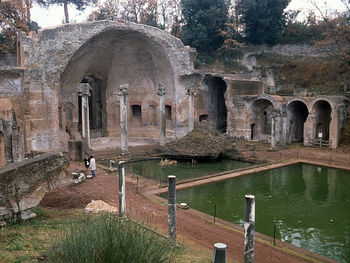Hadrian's Villa

The Canopus, a canal built in the style of the canal at Alexandria.[1]
Hadrian's Villa was built between A.D. 118 and 133 by the Emperor Hadrian in Tivoli, about 17 miles (28km) east of Rome. It was a complex of some 30 buildings,[2] and with about 900 rooms it is the largest known Roman villa. Even before Hadrian began his building programme, the settlement of Tivoli was home to several villas belonging to the Roman elite, about 35 of which can be identified today. Hadrian was a patron of architecture, in particular he commissioned a mausoleum in Rome which still stands (known today as the Castel Sant'Angelo), and rebuilt the Pantheon. His villa at Tivoli used the latest construction techniques, for example the use of concrete. Though the site is today known as Hadrian's Villa or the Villa Adriana, during the Roman period it was called the villa Tiburtina or villa Tiburtis after the nearby Via Tiburtina, and the villa Aelia (Hadrian's family name was Aelius).[3]
On the site of Hadrian's Villa was an earlier villa, dating from the 2nd or 1st century B.C., but it is uncertain who owned it. This structure was incorporated into that built by Hadrian. How far the villa and its estates extended is uncertain, and estimates are as high as 120 hectares. Amongst the vast array of rooms were sumptuous baths, luxurious accommodation for the imperial households and its attendants, and areas for hosting guests. Hadrian sometimes carried out the work of government from the villa, and met important guests within its rooms. The main construction work seems to have ended with Hadrian's death in 138. Though it is known the villa was a favoured residence of Hadrian, it is uncertain how it was used after his death, though statues from the 3rd century indicate it remained in useful for some time. In its later history the villa was pillaged and much of its artwork appropriated for use elsewhere. It became a popular tourist destination and has been designated a World Heritage site by UNESCO since 1999.[4][5]
References
- ↑ Castex, Jean (2008). Architecture of Italy. ABC-CLIO. p. 62. ISBN 9780313350870.
- ↑ Le Glay, Marcel; Voisin, Jean-Louis; Le Bohec, Yann; Cherry, David & Kyle, Donald (2006). A History of Rome, 3rd edition. p. 293. Blackwell Publishing. ISBN 1-4051-1083-X.
- ↑ Gagarin, Michael (2010). The Oxford Encyclopedia of Ancient Greece and Rome. pp. 376–377. Oxford: Oxford University Press. ISBN 978-0-19-517072-6.
- ↑ Gagarin, Michael (2010). The Oxford Encyclopedia of Ancient Greece and Rome, pp. 376–378.
- ↑ Villa Adriana (Tivoli), UNESCO, retrieved on 30 September 2012.
